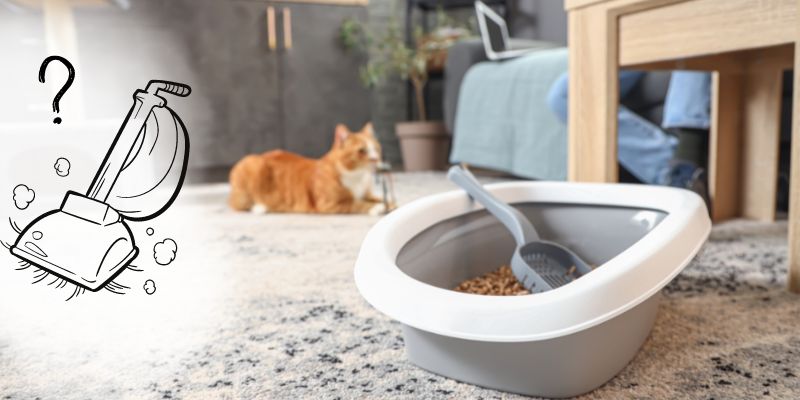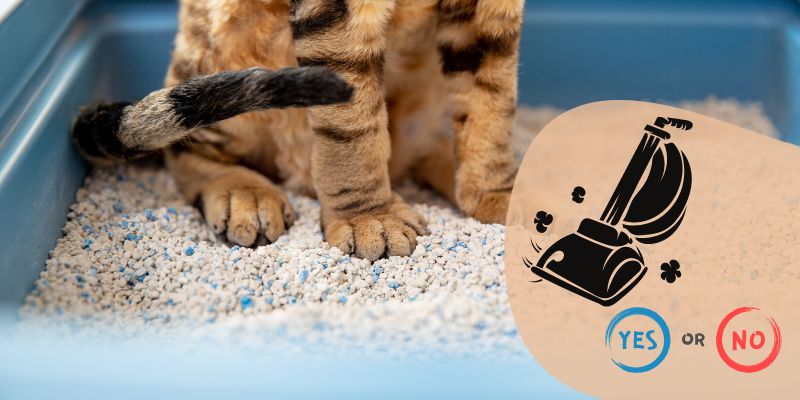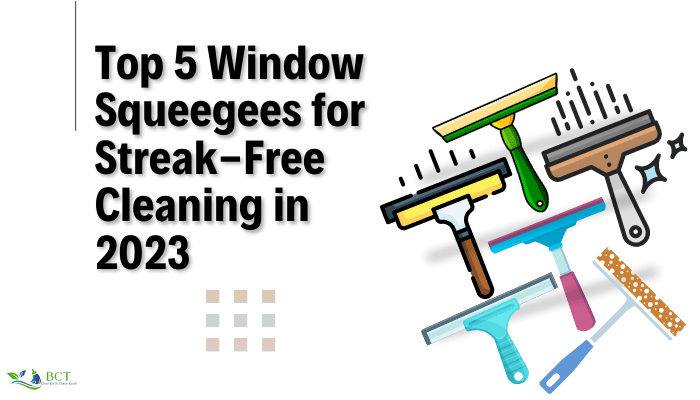Yes, you can vacuum cat litter, but with caution! While it’s a quick way to clean up scattered litter, it can damage your regular vacuum cleaner.
For a spotless litter area, skip the regular vacuum! Opt for a pet-specific model designed vacuum to handle litter’s dust and mess. They’re built tough to avoid clogs and have stronger filters to trap allergens.
Remember, only vacuum dry litter – wet clumps can wreak havoc on your machine. Empty often to maintain suction, and consider disposable dust bags for easy litter disposal without spreading dust clouds. ✨
How To Vacuum Cat Litter? Efficient Tips!

Vacuuming cat litter can be an efficient and easy way to keep your home clean and tidy. We gathered 08 small steps to make your work simple and quick.
Materials needed:
- A vacuum cleaner with a hose attachment
- A dustbin or vacuum bag
- A mask (optional)
Step 1: Choose the right vacuum cleaner
Choose a vacuum cleaner that has a hose attachment to allow you to easily reach all areas where the cat litter may be present. Make sure the vacuum is clean and free of debris.
Step 2: Put on a mask (optional)
If you are sensitive to dust and debris, it is recommended to wear a mask to avoid inhaling any particles.
Step 3: Remove the cat from the area
If your cat is nearby, it is best to remove them from the area to avoid any stress or discomfort.
Step 4: Prepare the vacuum
Attach the hose attachment to the vacuum and check that it is secure. Make sure the dustbin or vacuum bag is empty or has enough space for the amount of litter you need to clean up.
Step 5: Start vacuuming
Begin by vacuuming around the litter box and surrounding areas where litter may have been tracked. Use the hose attachment to get into corners and hard-to-reach areas. Be sure to vacuum any loose litter that has spilled outside the litter box.
Step 6: Vacuum the litter box
Remove any remaining litter from the box and vacuum the inside to remove any dust and debris that may have accumulated.
Step 7: Dispose of the debris
Empty the dustbin or vacuum bag into a trash bag and dispose of it properly.
Step 8: Clean the vacuum
Clean the vacuum, hose attachment, and dustbin or vacuum bag thoroughly to avoid any leftover debris or odor.
That’s it! By following these simple steps, you can easily vacuum your cat’s litter and keep your home clean and fresh.
Pros And Cons of Using a Vacuum for Cleaning Cat Litter

Pros:
- Quick and Efficient: Using a vacuum can make cleaning up cat litter quick and efficient. It can suck up the litter and any debris around the litter box, leaving the area clean in just a few minutes.
- Reduces Odors: Cat litter can produce unpleasant odors, but a vacuum can help reduce these odors. By quickly removing any litter or debris, there is less time for the odors to linger.
- Less Physical Strain: Scooping cat litter can be physically demanding, especially if you have multiple cats or heavy litter boxes. Using a vacuum can reduce the strain on your back and arms, making it a more comfortable and convenient option.
Cons:
- Risk of Clogging: Cat litter can be very fine and may clog a vacuum’s filters or hose. This can cause the vacuum to stop working or require frequent cleaning of the filters.
- Messy: Using a vacuum can be messy if you don’t have the right attachments or if the vacuum is not powerful enough. The litter may scatter around the area, creating more mess to clean up.
- Health Risks: Cat litter may contain harmful bacteria and viruses that can cause health issues if inhaled. Using a vacuum can stir up dust and litter particles, increasing the risk of respiratory issues.
Precautions to Take When Vacuuming Cat Litter
Vacuuming cat litter can be a convenient and efficient way to keep your home clean, but it’s important to take certain precautions to protect your health and prevent cross-contamination.
Use a Dedicated Vacuum Cleaner
One of the most important precautions is to use a dedicated vacuum for cat litter. This means having a separate vacuum that is only used for cleaning up cat litter, rather than using the same vacuum you use for other areas of your home.
This can help prevent cross-contamination and reduce the risk of health issues.
02. Choose The Right Tools
Another key precaution is to use the right attachments on your vacuum. Using the wrong attachments can lead to clogging, which can make the cleaning process more difficult and less effective.
Make sure to use attachments that are specifically designed for cleaning up cat litter, such as those with strong suction and specialized brushes.
03. Wear Mask
It’s also important to wear a mask when vacuuming cat litter. This is because cat litter can contain harmful bacteria and viruses that can be easily inhaled, leading to respiratory issues and other health problems. A mask can help filter out these particles and reduce your risk of exposure.
04. Clean Your Vacuum Regularly
In addition to these precautions, it’s important to clean your vacuum regularly to prevent the buildup of bacteria and other harmful particles.
This includes emptying the vacuum’s dustbin or bag after each use and wiping down the vacuum’s exterior and attachments with a disinfectant.
By taking these precautions, you can safely and effectively vacuum cat litter without putting your health at risk or contaminating other areas of your home.
FAQs
Is it safe to vacuum cat litter?
Vacuuming cat litter can be safe if you take the necessary precautions such as using a dedicated vacuum for cat litter, wearing a mask, and using the appropriate attachments to avoid clogging.
Can you use a regular vacuum to clean cat litter?
No, don’t use a regular vacuum for cleaning cat litter as it can damage the vacuum or create a mess. Instead, use a dedicated vacuum designed for cleaning cat litter.
What kind of vacuum is best for cleaning cat litter?
A vacuum with powerful suction and appropriate attachments is best for cleaning cat litter. Consider investing in a vacuum specifically designed for cleaning cat litter to avoid clogging and ensure efficient cleaning.
How often should you clean the vacuum after using it to clean cat litter?
We recommend you clean the vacuum after every use to prevent the buildup of bacteria and germs. Empty the canister or replace the bag, and clean the filters and attachments thoroughly.
Are there other alternatives to vacuuming cat litter?
Yes, there are other alternatives to vacuuming cat litter, such as using a litter mat to collect excess litter, investing in a self-cleaning litter box, or using a scooper to remove the litter manually.
Conclusion:
In conclusion, using a vacuum for cleaning up cat litter has both pros and cons. While it can make the process quick and efficient, it can also be messy and potentially harmful to your health. If you decide to use a vacuum, make sure to take the necessary precautions to ensure safe and efficient cleaning.
Alternatively, there are other options such as using a litter mat or investing in a self-cleaning litter box that may be more suitable for your needs.


